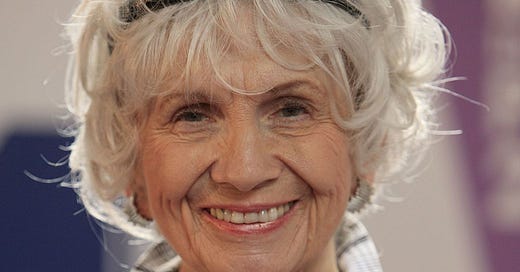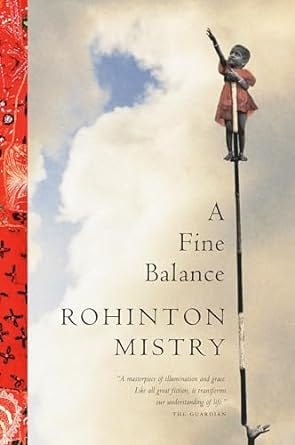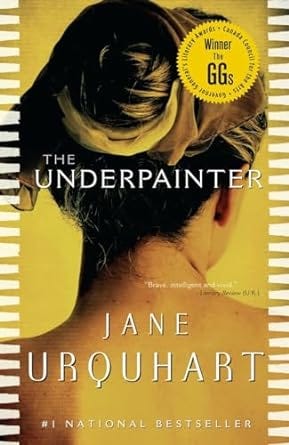Update: Several weeks after I published this post, Alice Munro’s daughter, Andrea Skinner, told the world of the fact that her stepfather had sexually assaulted her, and that after her mother learned this, she continued to live with him until his death. I will point you to this excellent essay about Alice Munro by that says everything that needs saying about this topic.
Alice Munro, Canadian literary giant, died on May 13th at age 92. This essay is part of the virtual memorial organized by
in her honour. Head over to in about a week to find a curated page of all the tributes.In 8th grade, I applied and was accepted into a specialized arts high school for their creative writing program. My acceptance confirmed my identity as a writer. Perhaps even more importantly at the time, it confirmed my identity as someone who belonged.
For the next four years, I took multiple buses across town to get to school, spending two to three hours in transit. I carried a little notebook in my crossbody purse, and a blue fountain pen with which to capture my observations and the snippets of lines I didn’t want to forget.
In 1996, when I started high school, literary works by BIPOC authors were not taking the English-speaking world by storm. I cannot remember a single piece we were given to study that told the story of non-white protagonists. Which isn’t to say that I was bothered by the lack of representation. I wasn’t. Rather than wonder if there were books out there with people whose lives more closely mirrored mine, I fretted about why my life looked nothing like theirs.
The poems and stories I was assigned were steeped in landscape and wildlife. Lines could be dedicated to describing the way a specific flower bloomed. Pages could be given over to explaining the movement of a fawn in the forest, the specific species of trees it passed, the specific treads on the ground it left, the specific shrubs from which it ate. I would reread these passages religiously, trying to drink in the details, to familiarize myself with the plants and animals. To learn enough about a birch and an oak and a maple and a dogwood that I could write my own paragraphs about them.
But what is and what isn’t political? The story of an Irish immigrant from 1880 written in 1980 is not political, because no one still doubts the Irish immigrant’s humanity.
It didn’t work. On my street, there was a canopy of trees, but I hardly paid attention to the species, only to the shade it gave us and the branches I could climb to look out over the neighbourhood.
The plants I knew intimately were the grape leaves my father picked along the forest path that led to the river, down the street from our house. While I couldn’t tell other tree species apart, I would always pride myself on the ability to distinguish a grape leaf from a maple leaf, mainly by the rounded indentation around the stem.
Baba would come home from his walks and bike rides with plastic grocery bags filled to the brim with these foraged leaves. He would boil and salt them, prepare the filling of rice, chopped parsley and ground beef, spicing it with cumin and black peppers. He would spend his evenings wrapping each boiled leaf around the stuffing to make the little fingers of his favourite Egyptian delicacy. Then we would feast, and the taste of Egypt would be there in our dining room in Ottawa.
There were other books, of course, even if they weren’t on my syllabus. Rohinton Mistry’s A Fine Balance1 was published in 1995. It spoke of another country, another set of challenges and difficulties and triumphs. I was wholly unequipped to write about Egypt the way he spoke about India, notwithstanding the fact that he was a master writer and I was just starting out. I, who had spent an accumulated total of 7 months of my life in Egypt, spread over various holidays, couldn’t possibly tell its story.
I wanted only to write CanLit2, because CanLit was what I was being assigned at school. That particular aesthetic, that story of “sad small towns… or heartwarming ones… of white-bread literature that was mostly about the past, with its sepia-toned covers, all with the back of a woman’s neck on them.”3
CanLit stories weren’t political. They weren’t about immigrants or their children navigating life in the new country. Or, when they were about immigrants, those immigrants came from Scotland and Ireland, and had arrived no later than 1905. If a language other than English was spoken in CanLit, it was Gaelic or Celtic. If an ocean was crossed, it was the Atlantic.
But what is and what isn’t political? The story of an Irish immigrant from 1880 written in 1980 is not political because no one still doubts the Irish immigrant’s humanity. If that story had been told in real time, it would have raised more eyebrows than something written with the benefit of hindsight.
To qualify as apolitical is a luxury, a privilege. Palestinian poet Marwan Makhoul laments that “in order for me to write poetry that isn’t political / I must listen to the birds / And in order to hear the birds / The warplanes must be silent.”
In the 10th and 11th grade, I fell down a Jane Urquhart rabbit hole, reading everything of hers I could get my hands on. Truthfully, I didn’t understand a single story. The plots were so sparse, so subtle.
What I did understand was the mood: serious and intense, not about much of anything at all to my 15 year old mind. Page after page where the landscapes described blankets of snow in the wilderness. Action happening beneath the surface, barely perceptible. Thick, lush forests. Characters who hunted or painted or lived in their cottages year round, away from the city.
I read Urquhart with equal parts fascination and dismay. This was what CanLit sounded like, I was certain. But try as I might to emulate it, my heavily researched stories about old artists living in small northern towns fell apart as quickly as I could get them down. Where Urquhart mesmerized with subtlety and minimal action, my imitations did nothing but make me bored and sleepy.
Write what you know, my teachers had told me, but every example we read in class had so little to do with what I knew. Every epic family saga traced back to a farm in the prairies or a small town in Scotland, landscapes and rituals I had never seen, a world assumed to be the default for which I had no reference.
Discouraged, I turned my attention to another giant in Canadian literature, Alice Munro.
Here, I found hope. Munro’s stories, unlike those of Urquhart — or Michael Ondaatje, another writer I was desperate to emulate — were less fussy. For one, I was able to follow the plot without losing myself in the scenery. The prose was elegant but spare. For another, Munro’s characters weren’t all artists and soldiers, or at least, that wasn’t a prerequisite.
Munro’s characters were ordinary people. Teachers, wives, sisters. Their concerns might be their boredom, their families, their expectations for life, their money or lack thereof. Alice’s stories – and I call her Alice not out of a lack of reverence but because she made me feel at home in her words – Alice’s stories were concerned with the mundane and the interior, and what made it human.
I have always loved the way Alice’s writing centers women and the challenges we face. But this is where my double consciousness kicks in. Recently, I reread Runaway, the story of a woman named Carla, navigating life with a controlling, emotionally manipulative husband. So much about Carla spoke to me. Her uncertainty and impulsiveness. Her imperfection. The way she cried constantly. The way she sought connection with animals like Flora, the goat that found a home in her barn.
Despite my love for this story, I hesitated to share it, to make it a part of this essay. Why? Because Muslim women are already perceived to be oppressed by the men in our lives. Because someone might wrongly take my mention of Carla’s struggles as a clue leading back to my own life.4
When there are so few examples of a group in the media, each representation holds inordinate weight. No matter how many times I say I am speaking only for myself, if you’ve never seen another Muslim woman, I have just become an avatar, a projection for millions of other people.
Alice wrote the stories of women before women were common protagonists. In fact, it was her writing that normalized us on the page. I don’t know if she struggled with this issue of representation. If she worried that her impulsive characters might make women seem hysterical or irresponsible. If she did, she pushed through to give us rich layering, to give us CanLit that was universal in its specificity. Even if you didn’t live in a small town in Northern Ontario. Even if you were the daughter of Egyptian immigrants, trying to find yourself in a classroom reading assignment.
I am trying to internalize this lesson. To write my reality because of the mess and humanity, not in spite of it. I am trying to widen what CanLit means so that there is room for stories like mine within it too5. This is what Alice taught me.
Thank you for reading Letters from a Muslim Woman. I share the joys and challenges of being a visibly Muslim woman in a sometimes-unfriendly world. A special shoutout to our newest paid subscribers,
and , , and . Thanks so much for the support!A paid subscription is $5 a month and gives you access to my unfinished letters, published every other week. If you’re enjoying my perspective and want to support me, consider upgrading to help me spend more time on writing and share a voice that isn’t often heard.
If you can’t commit to a monthly subscription, but still want to support my work, you can buy me a coffee below. It helps me more than you realize.
It’s important to note that Rohinton Mistry is a Canadian author, whose family is originally from India. That said, in the 90’s, for all the acclaim his book got, it wasn’t generally seen as CanLit.
CanLit, short for Canadian Literature, is a specific kind of writing. To read about the origins of CanLit, see this article: https://macleans.ca/culture/books/how-canlit-was-born/
This quote comes from an article in The Globe and Mail, Canada’s newspaper of record. You can find the full article here, https://www.theglobeandmail.com/arts/article-canlit-isnt-what-it-used-to-be/ and here, https://archive.ph/aDowV#selection-2545.172-2545.561
And here is the obligatory disclaimer that Carla resonating with me has nothing to do with how I feel about the men in my life. My father is ridiculously soft spoken. My husband and I treat each other as independent equals. I love the story because in spite of these differences, Carla is still relatable. As is Sylvia, the other female character.
CanLit has changed so much over the past 2-3 decades. If you look at bestselling and award-winning books by Canadian authors today, you’ll find BIPOC authors like Elamin AbdelMahmoud, Lawrence Hill, Omar El Akkad, Souvankham Thammavongsa, Esi Edugyan, Vincent Lam, Waubgeshig Rice, and so many more. I’m so grateful for the diversity of voices now in this space.











Always a treat to read you Noha! Can lit can only be improved by the addition of your writing.
I feel really lovingly called out by this piece, especially by your quotation from Marwan Makhoul: “in order for me to write poetry that isn’t political / I must listen to the birds / And in order to hear the birds / The warplanes must be silent...” How many years did I spend writing about the color of the canopy of leaves where I would adventure as a kid? Even if I was extremely lonely going out into the woods (is extreme loneliness an essential quality for any nascent writer?) I was always permitted to go. And the sky was mostly quiet, except for the birds.